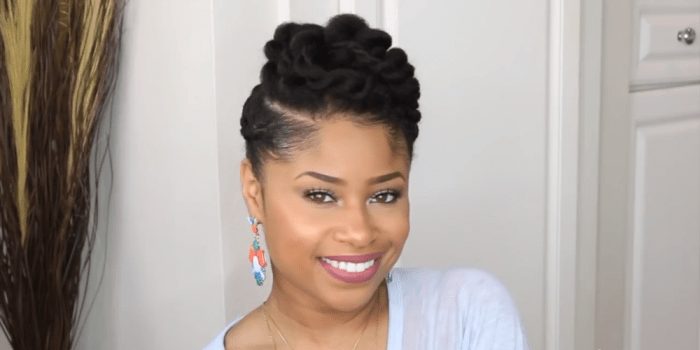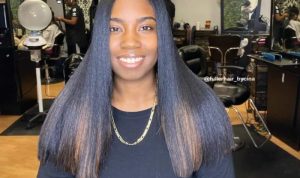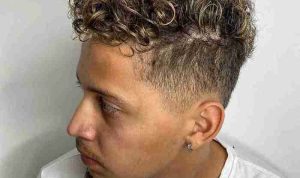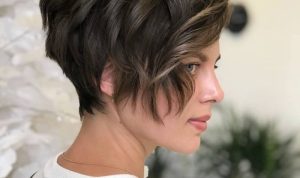Natural Hair Updos: A Celebration of Versatility and Beauty: Updo Hairstyles For Natural Hair
Updo hairstyles for natural hair – Natural hair updos offer a stunning array of styles, showcasing the beauty and versatility of textured hair. From elegant formal looks to casual everyday styles, updos provide a practical and aesthetically pleasing way to manage natural hair of various textures, while also protecting it from environmental damage. This exploration delves into the world of natural hair updos, covering various styles, techniques, and maintenance tips.
Introduction to Natural Hair Updos
Updos for natural hair are incredibly versatile, offering a spectrum of styles to suit any occasion or personal preference. The beauty lies in the ability to highlight the unique texture and patterns of natural hair, creating looks that range from sleek and sophisticated to playful and whimsical. The benefits extend beyond aesthetics; updos are excellent protective styles, minimizing manipulation and reducing breakage, especially crucial for hair types 4a, 4b, and 4c which are prone to dryness and fragility.
Historically, many African-inspired updos, such as bantu knots and cornrows, have deep cultural significance, representing heritage and artistry. These styles have evolved and adapted, seamlessly integrating into modern fashion and trends.
Popular Updo Styles, Updo hairstyles for natural hair
Several popular updo styles cater to different hair lengths, textures, and skill levels. The following table illustrates some of the most common and easily achievable styles.
| Style Name | Description | Technique | Ideal Hair Texture |
|---|---|---|---|
| High Bun | A classic updo where the hair is gathered high on the head and secured into a bun. Variations include messy buns, sleek buns, and topknots. | Hair is typically gathered into a ponytail, then twisted or wrapped around itself before securing with elastics or pins. | Suitable for all hair textures. |
| Twist-Out Bun | Two-strand twists are created throughout the hair, then bunned together. This style offers a more textured and voluminous look. | Hair is sectioned and two-strand twists are made. Once the twists are set, they are gathered into a bun. | Best for 4a-4c hair textures. |
| Bantu Knot Updo | Small sections of hair are twisted or coiled into knots, creating a unique and textured updo. | Hair is sectioned into small parts, each section is twisted or coiled, and secured with pins. | Works well with 4b and 4c hair. |
| Puff | A simple and quick style where the hair is gathered at the crown of the head to create a voluminous puff. | Hair is smoothed and gathered at the crown, secured with an elastic or hair tie. | Suitable for all hair textures. |
Creating a high bun involves several steps. One method involves gathering the hair into a high ponytail, securing it with an elastic band, then twisting the ponytail around itself before pinning it securely. Alternatively, the hair can be wrapped around the base of the ponytail, creating a more polished look. A third technique involves creating a flat twist or braid before wrapping it into a bun.
A sleek low bun can be achieved by first smoothing the hair with a hair product, such as a gel or leave-in conditioner. The hair is then gathered low at the nape of the neck, creating a tight ponytail. The ponytail is then wrapped around itself, creating a neat bun. Secure the bun with bobby pins, tucking away any loose strands for a polished look.
Hair Preparation and Products

Source: latest-hairstyles.com
Proper hair preparation is crucial for successful updo styling. Pre-styling techniques like stretching or detangling help prevent breakage and ensure a smoother finish. Stretching can be achieved through methods such as banding, braiding, or African threading. Detangling should be done gently to avoid pulling or damaging the hair. Use a wide-tooth comb or your fingers, working from the ends to the roots.
Various products can aid in the process.
Gel provides a strong hold and sleek finish, ideal for styles like sleek buns. Creams offer moisture and definition, enhancing texture and preventing frizz. Oils provide added moisture and shine, protecting the hair from dryness. Choosing the right combination depends on your hair type and desired outcome. For example, a 4c hair type might benefit from a leave-in conditioner and a curl cream before styling, while a 4a type might need less moisture and more hold.
Maintaining moisture and preventing breakage during updo creation requires gentle handling and the right products. Using a moisturizing leave-in conditioner before styling helps to prevent dryness and breakage. Avoid excessive pulling or tugging on the hair. Apply a light oil to the ends to seal in moisture and prevent split ends.
Updo Styles for Different Occasions
Updos are adaptable to various occasions, offering styles for both formal and informal settings. Formal events such as weddings or galas often call for sophisticated, intricate updos. These may involve braids, twists, or decorative accessories. A sleek chignon or an elegant bun adorned with hairpins are excellent choices.
Casual everyday updos should be quick and easy to create. A simple high bun, a messy bun, or a puff are all suitable options for everyday wear. These styles are practical and require minimal styling time. They can also be easily adapted to suit various occasions by adding accessories or changing the overall shape and texture.
For athletic activities, updos should be secure and comfortable. A high ponytail, a tight bun, or braids are all suitable options. These styles will keep the hair out of the face and prevent it from interfering with physical activity. Using hair ties and bobby pins that are sturdy and comfortable will help prevent the style from coming undone during activity.
Troubleshooting Common Issues
Common problems encountered while styling natural hair updos include frizz, slippage, and flyaways. Frizz can be minimized by using anti-frizz products and ensuring the hair is properly moisturized. Slippage can be prevented by using a strong-hold gel or hairspray. Flyaways and loose strands can be tamed with edge control or bobby pins.
Solutions for dealing with flyaways include using a smoothing serum or edge control gel. Loose strands can be secured with bobby pins or hair ties. To extend the lifespan of an updo, use a satin bonnet or scarf to protect the hair at night.
Advanced Updo Techniques
Incorporating braids or twists adds complexity and visual interest to updos. Braids can be used to create a base for the updo, adding texture and volume. Twists can be incorporated into the updo itself, creating a more intricate and detailed look. Accessories such as hairpins, headbands, and decorative clips can elevate the look and add a personal touch.
Creating intricate updos often requires practice and patience. Start with simpler styles and gradually work your way up to more complex designs. Using visual aids and tutorials can be beneficial in learning new techniques. A complex updo might involve combining multiple braiding techniques, incorporating twists, and strategically using accessories for a polished and sophisticated finish.
Maintaining Healthy Natural Hair

Source: naturallyyoumag.com
Regular deep conditioning treatments are essential for maintaining the health of updo-styled hair. Deep conditioning helps to replenish moisture and repair any damage caused by styling. It is recommended to deep condition at least once a week, or more frequently if needed.
Protecting natural hair from damage caused by styling involves using gentle techniques, avoiding excessive heat, and using the right products. Avoid pulling or tugging on the hair, and use a wide-tooth comb or your fingers to detangle. Limit the use of heat styling tools, and always use a heat protectant if you do use them.
Protective styling, such as updos, plays a vital role in natural hair growth. By minimizing manipulation and protecting the hair from environmental damage, protective styles help to retain length and improve overall hair health. Regular deep conditioning and gentle handling are key to maximizing the benefits of protective styling.
Commonly Asked Questions
How often should I wash my hair when wearing an updo?
The frequency depends on your hair type and scalp. Generally, washing every 1-2 weeks is recommended to prevent buildup and maintain scalp health. Use a moisturizing shampoo and conditioner.
Can I sleep with my updo in?
It’s best to take down your updo before sleeping to reduce friction and potential breakage. If you must sleep with it in, use a satin scarf or bonnet to protect your hair.
How can I prevent my updo from becoming too tight?
Avoid pulling your hair too tightly when styling. Use gentle techniques and focus on creating a secure yet comfortable style. If it feels tight, loosen it immediately.
What products are best for creating a sleek updo?
Edge control gels, hair oils, and smoothing creams can help achieve a sleek finish. Experiment to find products that work best for your hair type.






